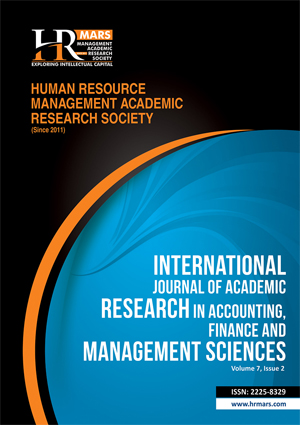
ISSN: 2225-8329
Open access
Drawing on signaling and proprietary cost theories, this paper explores the drivers of voluntary human capital information disclosure. Using content analysis of the five year (From 2012 to 2016) annual reports of 12 Deposit Money Banks(DMBs)in Nigeria, a data set was collected. The data set collected was analyzed by means of Panel Corrected Standard Error (PCSE) model estimation method. The results of the analysis indicate that whereas corporate size and human capital performance have significant positive effects on the extent of human capital information disclosure, corporate profitability has insignificant positive effect on it. The study results provide an insight that would serve as a robust empirical basis for policy makers and regulators to develop human capital reporting guidelines for corporates.
Abdulhay, D., Ragab, N. S., & Hegazy, W. (2018). The Determinants of Human Capital Voluntary Disclosures in the Lebanese Commercial Banks. Academy of Accounting and Financial Studies Journal,22(6), 1-18.
Abdul Rahman, M. R. C. (2013). A longitudinal and cross-sectional examination of intellectual capital information disclosure in six large ftse 100 UK companies 1974-2008, doctoral dissertation, Newcastle University, Newcastle Upon Tyne.
An, Y. (2012). Voluntary disclosure of intellectual capital in Chinese (mainland) companies”. Doctoral dissertation. Retrieved from:
https://researchcommons.waikato.ac.nz/handle/10289/6581 (accessed 20 February 2017).
Ahsan, M. K. (2016). Measuring financial performance based on camel: A study on selected Islamic banks in Bangladesh. Asian Business Review, 6(13), 47-56.
Ali, M., & Ahmed, T. (2019). Association of Organizational Attributes With Human Resource Disclosure: Evidence From Bangladeshi Banks. International Journal of Accounting and Financial Reporting, 9(2), 99-115.
Beattie, V., & Thomson, S. J.(2006). Lifting the lid on the use of content analysis to investigate intellectual capital disclosures. Retrieved from:
https://www.hw.ac.uk/schools/img/dp2006af01.pdf, (accessed 20 August2017).
Benevene, P., & Cortini, M. (2010). Interaction between structural capital and human capital in Italian NPOs: Leadership, organizational culture and human resource management. Journal of Intellectual Capital, 11(2), 123-139.
Boujelbene, M. A., & Affes, H.(2013). The impact of intellectual capital disclosure on cost of equity capital:A case of French firms. Journal of Economics, Finance and Administrative Science, 18(34), 45-53.
Bontis, N. (1998). Intellectual capital: An exploratory study that develops measures and models. Management Decision, 36(2), 63–76.
Batista, F., & Macagnan, C.B. (2013). Factors explaining the level of voluntary human capital disclosure in the Brazilian capital market. Intangible Capital, 9(1): 305-321. http://dx.doi.org/10.3926/ic.315
Goldin, C. (2014). Human Capital. Retrieved from:
https://scholar.harvard.edu/files/goldin/files/human_capital_handbook_of_cliometrics_0. pdf (accessed 28 November 2020).
Hossain, S. (2016). Foreign direct investment (FDI) and corruption: Is it a major hindrance for encouraging inward FDI?. African Journal of Business Management, 10(10), 256-269.
Lajili, K., & Ze ´ghal, D. (2006). Market performance impacts of human capital disclosures. Journal of Accounting and Public Policy, 25, 171–194
Mishra, L., & Mishra, R. (2017). Human Resource Disclosure and its Association with Corporate Attributes. Global Journal of Management and Business Research: G Interdisciplinary, 17 (5), 9-18.
Mohammed, S. D. (2018). Mandatory Social and Environmental Disclosure: A Performance
Evaluation of listed Nigerian Oil and GasCompanies Pre- and Post-mandatory DisclosureRequirements. Journal of Finance and Accounting, 6(2), 56-68.
Möller, K., Gamerschlag, R., & Guenther, F. (2011). Determinants and effects of human capital reporting and controlling. Journal of Management Control, 22, 311–333.
Nickolas, S. (2019). What is the Relationship between Human Capital and Economic Growth? Retrieved from https://www.investopedia.com/ask/answers/032415/what-relationship-between-human-capital-and-economic-growth.asp(March 14 2021)
Nonaka, I. (1994). A dynamic theory of organizational knowledge creation. Organization Science, 5(1), 4-37.
Onuoha, N. E., Ofoegbu, G. N., Okafor, R. G., & Onodugo, V. A. (2020). Voluntary disclosure of intellectual capital information by deposit money banks in Nigeria. Journal of Intellectual Capital, 21(6), 1035-1052.
Raimo, N., Ricciardelli, A., Rubino, M., & Vitolla, F. (2020). Factors affecting human capital disclosure in an integrated reporting perspective. Measuring Business Excellence, 24(4), 575-592.
Scott, T. W. (1994). Incentives and disincentives for financial disclosure: voluntary disclosure of defined benefit pension plan information by Canadian Firms. The Accounting Review, 69 (1), 26-43.
In-Text Citation: (Onuoha & Okoye, 2022)
To Cite this Article: Onuoha, N. E., & Okoye, G. O. (2022). Determinants of Voluntary Human Capital Information Disclosure: Evidence from Deposit Money Banks in Nigeria. International Journal of Academic Research in Accounting Finance and Management Sciences, 12(1), 144–154.
Copyright: © 2022 The Author(s)
Published by HRMARS (www.hrmars.com)
This article is published under the Creative Commons Attribution (CC BY 4.0) license. Anyone may reproduce, distribute, translate and create derivative works of this article (for both commercial and non-commercial purposes), subject to full attribution to the original publication and authors. The full terms of this license may be seen at: http://creativecommons.org/licences/by/4.0/legalcode